#data harmonization techniques
Explore tagged Tumblr posts
Text
Data Harmonization Service, Tool, Software | PiLog Group
Data harmonization aligns disparate data sources into a central location through matching, merging, and transformation processes for streamlined data management.
#Data Harmonization#Data Harmonization solutions#Data Harmonization Tools#Data Harmonization Techniques#Data Harmonization Process#MDM Tools
0 notes
Text
Data Harmonization Service, Tool, Software | PiLog Group
Data harmonization aligns disparate data sources into a central location through matching, merging, and transformation processes for streamlined data management. https://www.piloggroup.com/data-harmonization.php
#Data Harmonization#Data Harmonization solutions#Data Harmonization Tools#Data Harmonization Techniques#Data Harmonization Process#MDM Tools
0 notes
Text
youtube
Embark on a captivating journey with us as we unfold the transformative story of our company's digital evolution. Witness the milestones, challenges, and triumphs that shaped our path from envisioning a digitally-driven future to making it a reality.
#best master data migration tools#master data management solutions#lean data consulting#what is master data management#data harmonization techniques#Youtube
0 notes
Text
Foods of the Ancient World: Tea

By AxelBoldt at en.wikipedia - Transferred from en.wikipedia, Public Domain, https://commons.wikimedia.org/w/index.php?curid=60236
Tea, specifically that made from pouring boiling water over the leaves of Camellia sinensis, which is native to East Asia, has a very long history. It is the second most commonly consumed drink in the world. It contains caffeine, which is a psychoactive substance that usually produces a stimulating effect on humans. While steeping other things in boiling water is frequently called tea, those are tisanes or infusions.

By Shannon - Background and river course data from http://www2.demis.nl/mapserver/mapper.asp, CC BY-SA 4.0, https://commons.wikimedia.org/w/index.php?curid=9633969
C. sinensis is an evergreen bush that probably originated near the source of the Irrawaddy River in Myanmar and spread into southeast China, Assam, and Indo-China, to an range of about 460,800 sq km from about latitude 95°-120°E and 11°-29°N. There are several varieties of tea that diverged based on the climate and may have hybridized with local plants.

By Shinno_(Shennong) inscribed artist not identified 19th century Japanese Wittig collection painting: artist not (yet) identified, photograph by uploaderderivative work: nagualdesign
Before it was made into a drink, tea leaves were eaten, perhaps millennia before it became a beverage. It's thought that tea drinking began in Yunnan for medicinal purposes. in Sichuan, 'people began to boil tea leaves for consumption into a concentrated liquid…using tea as a bitter yet stimulating drink'. Legends put the origin of tea drinking in mythical Shennong, around central China, in 2737 BCE, though evidence points that being brought from Yunnan and Sichuan. The oldest evidence of tea drinking was found in the mausoleum of Emperor Jing of Han, who died in 141 BCE. The earliest written evidence of tea dates to about 59 BCE in 'The Contract for a Youth' by Wang Bao which state that a youth how to brew and procure tea. Hua Tuo, who lived from about 140-208 CE, wrote that 'to drink bitter t'u constantly makes one think better'.

By Sanjay Acharya - Own work, CC BY-SA 3.0, https://commons.wikimedia.org/w/index.php?curid=4679972
It wasn't until the mid-8th century CE, under the Tang dynasty, that tea drinking spread outside of southern China into the rest of China, Korea, and Japan. It is also under the Tang dynasty that various processing techniques were developed, including stirring leaves in a hot, dry pan to control oxidization.

By Liu Songnian - https://www.shuge.org/meet/topic/119950/, Public Domain, https://commons.wikimedia.org/w/index.php?curid=141419610
Tea plays a very important part in social rituals in Confucian thought, which has its origins going back to the teachings of Kongzi, who lived from 551-479 BCE. Its part of the social ritual, among the family, for one's self-cultivation, and promoting humility. Among Chán Buddhists, which has its origins about 500 CE, where tea is used by monks to improve their concentration and wakefulness during meditation. Daoists, which have their origin going back to the Warring States period, from 450-300 BCE, value tea for promoting health, believing it to help balance and harmonize the qi as well as helping one to attain enlightenment.
4 notes
·
View notes
Text
Building Success with an Advanced Marketing Framework
Competitive digital world, understanding and implementing an Advanced Marketing Framework is crucial for brands aiming to capture, retain, and grow a strong customer base. A well-structured framework provides the roadmap for navigating dynamic customer needs, optimizing marketing efforts, and scaling business growth. By analyzing data, segmenting audiences, and delivering the right message at the right time, brands can engage customers and drive conversions effectively.
Understanding the Concept of an Advanced Marketing Framework
An Advanced Marketing Framework is a structured approach that combines strategies, tools, and analytics to enhance marketing effectiveness. It goes beyond traditional marketing methods, diving deeper into data-driven insights, real-time adjustments, and customer-centric tactics. Unlike basic frameworks, an advanced one integrates sophisticated techniques such as machine learning, behavioral segmentation, and cross-channel analysis to optimize results.
Creating an Advanced Marketing Framework is about harmonizing various elements, including customer data, brand messaging, channels, and feedback mechanisms, to offer a more cohesive experience across touchpoints. This approach increases brand loyalty and facilitates a seamless buyer journey from awareness to purchase.
Key Components of an Advanced Marketing Framework
Building an Advanced Marketing Framework requires more than just a few tweaks to traditional methods; it needs a holistic structure encompassing essential components:
1. Customer-Centric Approach
A customer-centric framework prioritizes the needs, desires, and behaviors of the target audience. By analyzing demographic, psychographic, and behavioral data, businesses can develop personalized campaigns that resonate with customers on a deeper level.
2. Data-Driven Insights
Data analytics is foundational to an Advanced Marketing Framework. With tools like Google Analytics, HubSpot, or more complex machine learning models, marketers can gain insights into customer behavior, engagement patterns, and conversion metrics. Leveraging data enables the fine-tuning of campaigns to maximize ROI and make informed decisions about where to allocate marketing resources.
3. Content Strategy and Personalization
Content remains a critical piece in engaging audiences. The Advanced Marketing Framework relies on content that is not only relevant but also tailored to individual customer segments. Personalization, such as dynamic emails, curated recommendations, or personalized landing pages, drives higher engagement and nurtures customer loyalty.
4. Omnichannel Marketing
In an Advanced Marketing Framework, omnichannel marketing ensures consistency across platforms, from email to social media to in-store experiences. Integrating channels allows for seamless transitions between touchpoints, enhancing the customer experience. This continuity helps brands reinforce messaging, nurture leads, and build stronger relationships with customers.
5. Automation and AI-Driven Strategies
Automation and artificial intelligence (AI) are game-changers in advanced marketing. Automated workflows can handle repetitive tasks, like sending follow-up emails or reminding customers about abandoned carts. AI-driven analytics provide deep insights into customer trends and forecast future behavior, making campaigns more targeted and efficient.
6. Continuous Optimization and Real-Time Adjustments
Unlike traditional frameworks, an Advanced Marketing Framework isn’t static. It requires constant optimization and real-time updates based on data analytics and customer feedback. A/B testing, conversion rate optimization, and performance monitoring are essential to ensure that campaigns are achieving their objectives and maximizing engagement.
7. Feedback and Adaptability
Customer feedback is an integral part of the Advanced Marketing Framework. Whether it’s through surveys, reviews, or social media comments, feedback helps brands understand customer sentiment, address concerns, and improve offerings.
Benefits of Implementing an Advanced Marketing Framework
Integrating an Advanced Marketing Framework offers substantial benefits:
Improved Customer Engagement: Personalized, data-driven strategies capture customer attention and keep them engaged across channels.
Higher Conversion Rates: By targeting the right audience with the right message, brands can enhance conversion rates and customer satisfaction.
Enhanced Efficiency: Automation and AI streamline operations, freeing up resources for creative, high-impact work.
Data-Backed Decisions: A reliance on data means that marketing decisions are well-informed and optimized for results.
Competitive Edge: Brands using an Advanced Marketing Framework stay ahead by adapting to customer preferences and market changes faster.
Getting Started with Your Advanced Marketing Framework
Creating and implementing an Advanced Marketing Framework might seem overwhelming, but starting with small steps can make a significant impact. Begin by clearly defining your target audience, outlining measurable objectives, and selecting the tools necessary for data analysis and automation.
Next, focus on omnichannel marketing strategies, ensuring your brand message is consistent across platforms. From here, experiment with content personalization and automation to enhance engagement. Remember to continually monitor and optimize your approach based on performance data and customer feedback.
2 notes
·
View notes
Text
The Role of AI in Music Composition
Artificial Intelligence (AI) is revolutionizing numerous industries, and the music industry is no exception. At Sunburst SoundLab, we use different AI based tools to create music that unites creativity and innovation. But how exactly does AI compose music? Let's dive into the fascinating world of AI-driven music composition and explore the techniques used to craft melodies, rhythms, and harmonies.

How AI Algorithms Compose Music
AI music composition relies on advanced algorithms that mimic human creativity and musical knowledge. These algorithms are trained on vast datasets of existing music, learning patterns, structures and styles. By analyzing this data, AI can generate new compositions that reflect the characteristics of the input music while introducing unique elements.
Machine Learning Machine learning algorithms, particularly neural networks, are crucial in AI music composition. These networks are trained on extensive datasets of existing music, enabling them to learn complex patterns and relationships between different musical elements. Using techniques like supervised learning and reinforcement learning, AI systems can create original compositions that align with specific genres and styles.
Generative Adversarial Networks (GANs) GANs consist of two neural networks – a generator and a discriminator. The generator creates new music pieces, while the discriminator evaluates them. Through this iterative process, the generator learns to produce music that is increasingly indistinguishable from human-composed pieces. GANs are especially effective in generating high-quality and innovative music.
Markov Chains Markov chains are statistical models used to predict the next note or chord in a sequence based on the probabilities of previous notes or chords. By analyzing these transition probabilities, AI can generate coherent musical structures. Markov chains are often combined with other techniques to enhance the musicality of AI-generated compositions.
Recurrent Neural Networks (RNNs) RNNs, and their advanced variant Long Short-Term Memory (LSTM) networks, are designed to handle sequential data, making them ideal for music composition. These networks capture long-term dependencies in musical sequences, allowing them to generate melodies and rhythms that evolve naturally over time. RNNs are particularly adept at creating music that flows seamlessly from one section to another.
Techniques Used to Create Melodies, Rhythms, and Harmonies
Melodies AI can analyze pitch, duration and dynamics to create melodies that are both catchy and emotionally expressive. These melodies can be tailored to specific moods or styles, ensuring that each composition resonates with listeners. Rhythms AI algorithms generate complex rhythmic patterns by learning from existing music. Whether it’s a driving beat for a dance track or a subtle rhythm for a ballad, AI can create rhythms that enhance the overall musical experience. Harmonies Harmony generation involves creating chord progressions and harmonizing melodies in a musically pleasing way. AI analyzes the harmonic structure of a given dataset and generates harmonies that complement the melody, adding depth and richness to the composition. -----------------------------------------------------------------------------
The role of AI in music composition is a testament to the incredible potential of technology to enhance human creativity. As AI continues to evolve, the possibilities for creating innovative and emotive music are endless.
Explore our latest AI-generated tracks and experience the future of music. 🎶✨
#AIMusic#MusicInnovation#ArtificialIntelligence#MusicComposition#SunburstSoundLab#FutureOfMusic#NeuralNetworks#MachineLearning#GenerativeMusic#CreativeAI#DigitalArtistry
2 notes
·
View notes
Text
Mastering Selenium Testing: Overcoming Common Automation Challenges
Introduction: Selenium, renowned for its prowess in automation testing, is a cornerstone of modern software development. However, as testers embark on their Selenium journey, they encounter various challenges that can impede the efficiency and effectiveness of their automation efforts. In this guide, we delve into the common hurdles faced in Selenium testing and explore strategies to overcome them, empowering testers to excel in their automation endeavors.

Navigating Cross-Browser Compatibility: Ensuring consistent performance across diverse browsers is paramount in web application testing. However, achieving cross-browser compatibility with Selenium poses its share of challenges. Testers must meticulously validate their scripts across multiple browsers, employing robust strategies to address discrepancies and ensure seamless functionality.
Taming Dynamic Element Identification: Dynamic web elements, a common feature in modern web applications, present a formidable challenge for Selenium testers. The ever-changing nature of these elements requires testers to adapt their automation strategies accordingly. Employing dynamic locators and resilient XPath expressions helps testers tame these dynamic elements, ensuring reliable interaction and seamless test execution.
Synchronizing Actions in Asynchronous Environments: The asynchronous nature of web applications introduces synchronization issues that can undermine the reliability of Selenium tests. To mitigate these challenges, testers must implement effective synchronization techniques, such as explicit and implicit waits, to harmonize test actions with the application's dynamic behavior. This ensures consistent and accurate test execution across varying environmental conditions.
Efficiently Handling Frames and Windows: Frames and windows are integral components of web applications, presenting unique challenges for Selenium automation. Testers must adeptly navigate these elements, employing tailored automation strategies to interact with elements nested within frames and manage multiple browser windows seamlessly. This ensures comprehensive test coverage and accurate validation of application functionality.
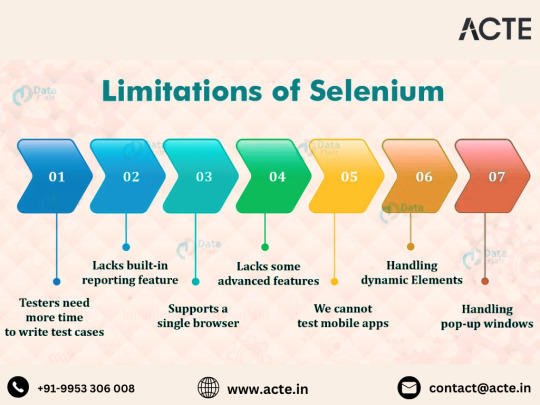
Unlocking Performance Testing Potential: While Selenium excels in functional testing, leveraging it for performance testing requires careful consideration. Testers must explore complementary tools and frameworks to simulate realistic user interactions and assess application performance under varying load conditions. This holistic approach ensures comprehensive test coverage and robust performance validation.
Streamlining Test Maintenance Processes: Maintaining Selenium test suites is a perpetual endeavor, necessitating proactive strategies to adapt to evolving application requirements. Testers must prioritize modularization and abstraction, enabling seamless updates and enhancements to test scripts. Embracing version control and continuous integration practices further streamlines the test maintenance process, ensuring agility and efficiency in automation efforts.
Enhancing Reporting and Debugging Capabilities: Effective test analysis hinges on robust reporting and debugging capabilities. Testers must augment Selenium's native features with third-party reporting tools and frameworks to generate comprehensive test reports and streamline issue identification and resolution. This empowers testers to glean actionable insights and drive continuous improvement in test automation practices.
Empowering Data-Driven Testing: Data-driven testing is a cornerstone of robust automation strategies, yet managing test data poses its own set of challenges. Testers must implement scalable solutions for test data management, leveraging data-driven testing frameworks and integration with test management tools to enhance test coverage and efficiency. This ensures comprehensive validation of application functionality across diverse scenarios.
Ensuring Consistent Test Environment Setup: Establishing a consistent test environment is essential for reliable and reproducible test results. Testers must invest in robust environment provisioning and configuration management practices, ensuring parity across development, staging, and production environments. This minimizes environmental discrepancies and enhances the reliability of automation efforts.
Leveraging Community Resources and Collaboration: Navigating the intricacies of Selenium testing requires collaboration and knowledge-sharing within the testing community. Testers must actively engage with forums, online communities, and documentation to leverage collective wisdom and address challenges collaboratively. This fosters a culture of continuous learning and innovation, propelling automation efforts to new heights.
Conclusion: While Selenium testing presents its share of challenges, adeptly navigating these hurdles empowers testers to realize the full potential of automation testing. By embracing best practices, leveraging complementary tools and frameworks, and fostering a collaborative testing culture, testers can overcome obstacles and unlock the true power of Selenium for test automation.
3 notes
·
View notes
Text
Navigating the Full Stack: A Holistic Approach to Web Development Mastery
Introduction: In the ever-evolving world of web development, full stack developers are the architects behind the seamless integration of frontend and backend technologies. Excelling in both realms is essential for creating dynamic, user-centric web applications. In this comprehensive exploration, we'll embark on a journey through the multifaceted landscape of full stack development, uncovering the intricacies of crafting compelling user interfaces and managing robust backend systems.

Frontend Development: Crafting Engaging User Experiences
1. Markup and Styling Mastery:
HTML (Hypertext Markup Language): Serves as the foundation for structuring web content, providing the framework for user interaction.
CSS (Cascading Style Sheets): Dictates the visual presentation of HTML elements, enhancing the aesthetic appeal and usability of web interfaces.
2. Dynamic Scripting Languages:
JavaScript: Empowers frontend developers to add interactivity and responsiveness to web applications, facilitating seamless user experiences.
Frontend Frameworks and Libraries: Harness the power of frameworks like React, Angular, or Vue.js to streamline development and enhance code maintainability.
3. Responsive Design Principles:
Ensure web applications are accessible and user-friendly across various devices and screen sizes.
Implement responsive design techniques to adapt layout and content dynamically, optimizing user experiences for all users.
4. User-Centric Design Practices:
Employ UX design methodologies to create intuitive interfaces that prioritize user needs and preferences.
Conduct usability testing and gather feedback to refine interface designs and enhance overall user satisfaction.

Backend Development: Managing Data and Logic
1. Server-side Proficiency:
Backend Programming Languages: Utilize languages like Node.js, Python, Ruby, or Java to implement server-side logic and handle client requests.
Server Frameworks and Tools: Leverage frameworks such as Express.js, Django, or Ruby on Rails to expedite backend development and ensure scalability.
2. Effective Database Management:
Relational and Non-relational Databases: Employ databases like MySQL, PostgreSQL, MongoDB, or Firebase to store and manage structured and unstructured data efficiently.
API Development: Design and implement RESTful or GraphQL APIs to facilitate communication between the frontend and backend components of web applications.
3. Security and Performance Optimization:
Implement robust security measures to safeguard user data and protect against common vulnerabilities.
Optimize backend performance through techniques such as caching, query optimization, and load balancing, ensuring optimal application responsiveness.
Full Stack Development: Harmonizing Frontend and Backend
1. Seamless Integration of Technologies:
Cultivate expertise in both frontend and backend technologies to facilitate seamless communication and collaboration across the development stack.
Bridge the gap between user interface design and backend functionality to deliver cohesive and impactful web experiences.
2. Agile Project Management and Collaboration:
Collaborate effectively with cross-functional teams, including designers, product managers, and fellow developers, to plan, execute, and deploy web projects.
Utilize agile methodologies and version control systems like Git to streamline collaboration and track project progress efficiently.
3. Lifelong Learning and Adaptation:
Embrace a growth mindset and prioritize continuous learning to stay abreast of emerging technologies and industry best practices.
Engage with online communities, attend workshops, and pursue ongoing education opportunities to expand skill sets and remain competitive in the evolving field of web development.
Conclusion: Mastering full stack development requires a multifaceted skill set encompassing frontend design principles, backend architecture, and effective collaboration. By embracing a holistic approach to web development, full stack developers can craft immersive user experiences, optimize backend functionality, and navigate the complexities of modern web development with confidence and proficiency.
#full stack developer#education#information#full stack web development#front end development#frameworks#web development#backend#full stack developer course#technology
2 notes
·
View notes
Text
Pioneering the Future of Software Quality Assurance through Automation Testing
Automation testing, a dynamic and essential software quality assurance technique, is reshaping the landscape of application testing. Its mission is to execute predefined test cases on applications, delivering heightened accuracy, reliability, and efficiency by automating tedious and time-consuming testing tasks.
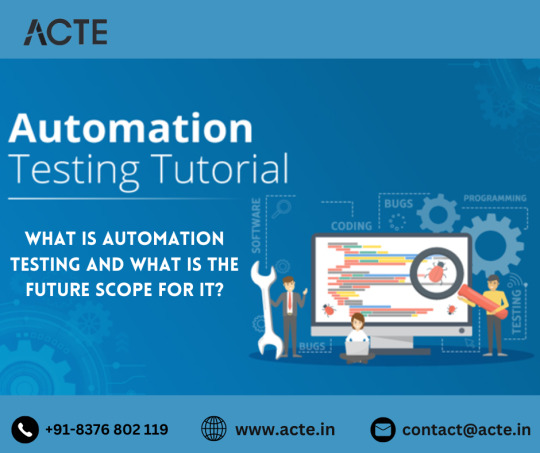
The Present and Future Synergy in Automation Testing:
At its essence, automation testing responds to the pressing need for a streamlined testing process. Beyond its current significance, the future promises a paradigm shift, characterized by transformative trends and advancements.
Unveiling Future Trends in Automation Testing:
Proactive "Shift-Left" Testing: Embracing a proactive "Shift-Left" approach, the future of automation testing integrates testing earlier in the development life cycle. This strategic shift aims to detect and address issues at their inception, fostering a more resilient and efficient software development process.
Harmonizing with DevOps: Automation is positioned to become increasingly integral to DevOps practices. Its seamless integration into continuous integration and delivery (CI/CD) pipelines ensures not just faster but more reliable releases, aligning seamlessly with the agile principles of DevOps.
AI and Machine Learning Synergy: The convergence of artificial intelligence (AI) and machine learning (ML) is poised to revolutionize automation testing. This integration enhances script maintenance, facilitates intelligent test case generation, and empowers predictive analysis based on historical data, ushering in a new era of adaptive and efficient testing processes.

Evolving Cross-Browser and Cross-Platform Testing: In response to the diversification of the software landscape, automation tools are evolving to provide robust solutions for cross-browser and cross-platform testing. Ensuring compatibility across diverse environments becomes paramount for delivering a seamless user experience.
Codeless Automation Revolution: The ascent of codeless automation tools represents a pivotal shift in testing methodologies. This trend simplifies testing processes, enabling testers with limited programming skills to create and execute automated tests. This democratization of testing accelerates adoption across teams, fostering a collaborative testing environment.
Concluding the Journey: Navigating Future Imperatives:
In conclusion, automation testing transcends its current role as a necessity, emerging as a future imperative in the ever-evolving landscape of software development. As technologies advance and methodologies mature, automation testing is poised to play a pivotal role in ensuring the delivery of high-quality software at an accelerated pace. Embracing these future trends, the software industry is set to embark on a transformative journey towards more efficient, adaptive, and reliable testing processes.
3 notes
·
View notes
Text
From Algorithms to Ethics: Unraveling the Threads of Data Science Education
In the rapidly advancing realm of data science, the curriculum serves as a dynamic tapestry, interweaving diverse threads to provide learners with a comprehensive understanding of data analysis, machine learning, and statistical modeling. Choosing the Best Data Science Institute can further accelerate your journey into this thriving industry. This educational journey is a fascinating exploration of the multifaceted facets that constitute the heart of data science education.
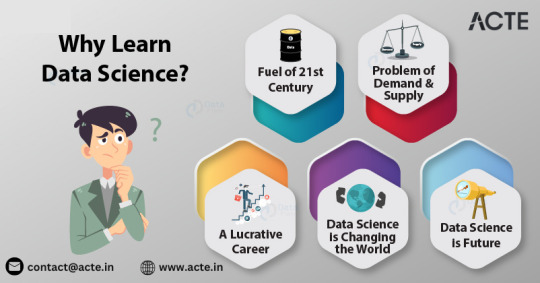
1. Mathematics and Statistics Fundamentals:
The journey begins with a deep dive into the foundational principles of mathematics and statistics. Linear algebra, probability theory, and statistical methods emerge as the bedrock upon which the entire data science edifice is constructed. Learners navigate the intricate landscape of mathematical concepts, honing their analytical skills to decipher complex datasets with precision.
2. Programming Proficiency:
A pivotal thread in the educational tapestry is the acquisition of programming proficiency. The curriculum places a significant emphasis on mastering programming languages such as Python or R, recognizing them as indispensable tools for implementing the intricate algorithms that drive the field of data science. Learners cultivate the skills necessary to translate theoretical concepts into actionable insights through hands-on coding experiences.
3. Data Cleaning and Preprocessing Techniques:
As data scientists embark on their educational voyage, they encounter the art of data cleaning and preprocessing. This phase involves mastering techniques for handling missing data, normalization, and the transformation of datasets. These skills are paramount to ensuring the integrity and reliability of data throughout the entire analysis process, underscoring the importance of meticulous data preparation.
4. Exploratory Data Analysis (EDA):
A vivid thread in the educational tapestry, exploratory data analysis (EDA) emerges as the artist's palette. Visualization tools and descriptive statistics become the brushstrokes, illuminating patterns and insights within datasets. This phase is not merely about crunching numbers but about understanding the story that the data tells, fostering a deeper connection between the analyst and the information at hand.
5. Machine Learning Algorithms:
The heartbeat of the curriculum pulsates with the study of machine learning algorithms. Learners traverse the expansive landscape of supervised learning, exploring regression and classification methodologies, and venture into the uncharted territories of unsupervised learning, unraveling the mysteries of clustering algorithms. This segment empowers aspiring data scientists with the skills needed to build intelligent models that can make predictions and uncover hidden patterns within data.
6. Real-world Application and Ethical Considerations:
As the educational journey nears its culmination, learners are tasked with applying their acquired knowledge to real-world scenarios. This application is guided by a strong ethical compass, with a keen awareness of the responsibilities that come with handling data. Graduates emerge not only as proficient data scientists but also as conscientious stewards of information, equipped to navigate the complex intersection of technology and ethics.
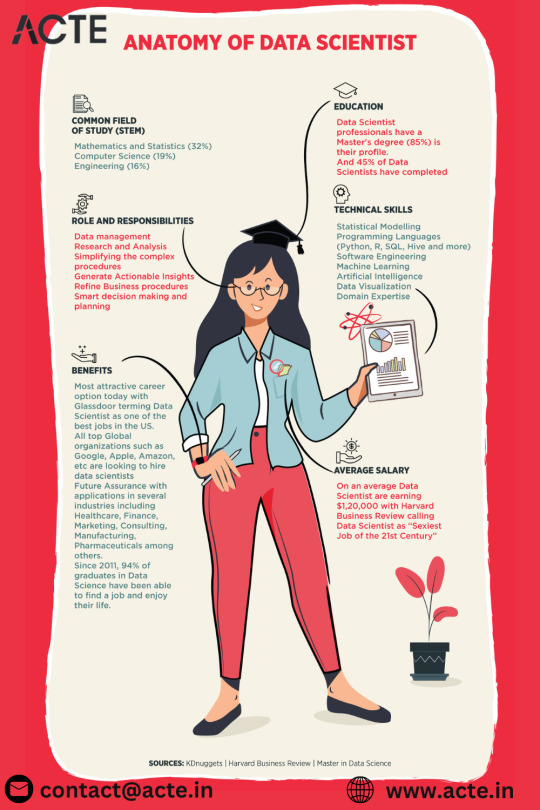
In essence, the data science curriculum is a meticulously crafted symphony, harmonizing mathematical rigor, technical acumen, and ethical mindfulness. The educational odyssey equips learners with a holistic skill set, preparing them to navigate the complexities of the digital age and contribute meaningfully to the ever-evolving field of data science. Choosing the best Data Science Courses in Chennai is a crucial step in acquiring the necessary expertise for a successful career in the evolving landscape of data science.
3 notes
·
View notes
Text
The Role of Business Intelligence in ERP Software
Enterprise Resource Planning (ERP) software providers like STERP (Shanti Technology), an excellent ERP software company in Madhya Pradesh, understand the value of Business Intelligence (BI) within this context. STERP, a leading provider of manufacturing ERP software in Indore, recognises the potential of business intelligence (BI) to turn collected data into a competitive advantage.
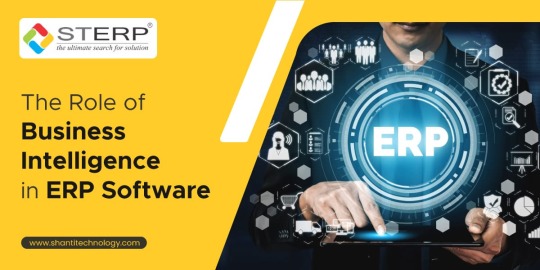
Business intelligence (BI) in the context of enterprise resource planning (ERP) refers to the processes involved in collecting, preparing, and analysing data from a wide variety of ERP subsystems. This suite of state-of-the-art methods and technologies produces insightful reports that may be used for strategic planning, performance monitoring, and operational optimisation.
STERP, a leading ERP software company in Madhya Pradesh and one of the top ERP solution providers in Indore understands the significance of a robust BI system for monitoring key performance indicators (KPIs), tracking trends, identifying patterns, and uncovering hidden opportunities and risks. Data analytics can be put to use in businesses for potential gains in productivity, cost savings, customer satisfaction, and innovation.
STERP, one of the most distinguished ERP software companies in Madhya Pradesh, promises cutting-edge BI tools in all of its ERP packages. By providing intuitive dashboards, customizable reports, and real-time analytics, STERP provides its customers with a bird's eye view of their operations. Let's explore the role that business intelligence plays in enterprise resource planning systems.
Data Integration and Consolidation for Informed Decision-Making:
Integrated and consolidated data is crucial for businesses like STERP, one of the most reliable ERP software providers in Madhya Pradesh, to make well-informed decisions. As an industry leader in manufacturing ERP software in Indore, STERP is well aware of the need of combining and integrating data from several sources.
The term "consolidation" refers to the process of collecting and harmonizing data from several locations. In its capacity as one of the leading ERP software firms in Madhya Pradesh and ERP solution providers in Indore, STERP facilitates the consolidation of data from disparate sources into a single repository. Data centralization ensures that all firm decision-makers and executives are using the same, reliable information.
Reporting and Analytics for Performance Monitoring:
In order to generate reports, it is necessary to construct and present organised data in an understandable and unambiguous way. STERP's ERP software makes it simple for businesses to tailor reports to their specific requirements, allowing for deeper analysis of sales, inventory, production, and finances.
By evaluating data and providing reports, STERP, a well-known manufacturing ERP software provider in Indore, aids numerous firms in gaining insight into their processes. Real-time dashboards and visualisations allow executives to identify bottlenecks, allocate resources effectively, streamline processes, and make educated strategic decisions.
Predictive Analytics and Forecasting for Strategic Planning:
Strategic decision-making at STERP, a distinct ERP software company in Madhya Pradesh, is significantly influenced by analytics and forecasting. As one of the most distinguished ERP solution providers in Indore, STERP recognises the significance of analytics and forecasting in directing business growth and strategy.
Utilising historical information, statistical algorithms, and machine learning techniques, predictive analytics allows for precise forecasting and prediction. In order to stay ahead of the competition, businesses can use predictive analytics to forecast demand, identify risks, determine the most efficient use of resources, and make other proactive decisions.
Self-Service BI and Empowering End Users:
Being one of the trusted ERP solution providers in Indore and a top manufacturing ERP software company in Indore, STERP appreciates the importance of self-service BI in empowering end users to make better, more efficient decisions.
Self-service BI allows end users to access and update data without involving IT or data analysts. To make data exploration, report preparation, and insight production accessible to users of all skill levels, STERP offers intuitive interfaces and clear tools. Users are empowered to make decisions at the moment based on accurate data without relying on IT, thanks to self-service BI.

Final Thoughts:
Business intelligence (BI) is crucial in ERP. Companies like STERP (Shanti Technology), a distinct ERP software company in Madhya Pradesh, appreciate the value of BI since it helps them to leverage data for strategic decision-making and planning. When businesses are able to consolidate and integrate their data, they are able to view the big picture of their operations, and the reporting and analytics functions give them insight into KPIs. In addition, businesses can use forecasting and predictive analytics to anticipate future trends, mitigate risks, and seize opportunities. Self-service BI provides end users with straightforward tools to access and analyse data on their own, fostering a culture of data-driven decision-making and increasing productivity.
#Manufacturing ERP software in Indore#ERP Software Company in Madhya Pradesh#ERP solution providers in Indore#ERP software Companies in Madhya Pradesh#manufacturer#ERP system#cloud ERP#ERP solutions#marketing#ERP software#engineering ERP#business#process
6 notes
·
View notes
Text

#lean data consulting#data harmonization techniques#data quality best practices#data harmonization process
0 notes
Text
Shaping Cities: The Role of Water in Urban Infrastructure
We embark on a journey through the intricate tapestry of water infrastructure and urban design, highlighting the symbiotic relationship between the two disciplines. Through the lens of survey and design, we uncover the pivotal role water plays in shaping the built environment and fostering sustainable communities. Join us as we navigate the interconnected realms of stormwater design, water network planning, and the integration of water supply networks into urban landscapes.
Stormwater Design: Crafting Resilient Communities
Stormwater design is not merely about managing rainwater; it’s about creating resilient communities that can weather the storms. By implementing innovative solutions such as green infrastructure and sustainable drainage systems, cities can mitigate flooding, reduce pollution, and enhance the quality of life for residents. Through careful planning and thoughtful design, stormwater infrastructure can harmonize with the natural environment while safeguarding against the impacts of climate change.
Water Network Planning: Orchestrating Fluidity
Water network planning is akin to conducting a symphony, orchestrating the flow of water through intricate networks of pipes and channels. From the sourcing of water to its distribution and consumption, every note must be carefully composed to ensure harmony and efficiency. Through advanced modeling techniques and data-driven analysis, planners can optimize water distribution systems to meet the needs of growing populations while minimizing waste and maximizing resilience
Integration of Water Supply Networks: Blending Form and Function
Water supply networks are not just utilitarian structures; they are integral components of the urban landscape. By seamlessly integrating water infrastructure into the fabric of the city, designers can create spaces that are both functional and aesthetically pleasing. From iconic water towers to innovative water features, the blending of form and function celebrates the vital role water plays in shaping our built environment.
Sustainable Urban Design: Balancing Nature and Technology
At the heart of water infrastructure and urban design lies the pursuit of sustainability. By embracing principles of sustainable design, cities can strike a delicate balance between nature and technology, ensuring the long-term health and vitality of both ecosystems and communities. Through green building practices, smart water management systems, and community engagement, cities can create environments that are not only resilient to environmental challenges but also foster a sense of connection and belonging among residents.
Conclusion:
As we navigate the complexities of urbanization and climate change, the intersection of water infrastructure and urban design becomes increasingly critical. By embracing a holistic approach that values sustainability, resilience, and community engagement, cities can create spaces that not only meet the needs of today but also lay the foundation for a more vibrant and resilient future. Join us on this journey as we explore the transformative power of water in shaping the cities of tomorrow.
Readmore: https://leenusindia.com/
#underground drainage systems
#water management
#urban water infrastructure

0 notes
Text
The Rise of Responsible AI: Balancing Innovation with Ethics in the Age of Automation
Arabian world media, in a world increasingly driven by Artificial Intelligence (AI), reflects how the concept of responsible AI has become more than just a trend—it’s a necessity. As industries across the globe embrace automation, machine learning, and data-driven decision-making, there is a growing demand to ensure that these technologies are developed and deployed ethically. The rise of responsible AI represents a critical turning point where innovation must harmonize with ethics, transparency, and accountability.
The conversation surrounding AI governance is especially relevant in rapidly advancing regions such as the Arabian world media landscape, where digital transformation is reshaping economies, societies, and communication platforms. From AI-powered journalism to automated content curation, the Arab world is becoming a fertile ground for both opportunities and challenges posed by emerging AI technologies.
The Promise and Peril of Artificial Intelligence
The electricity of AI algorithms lies of their capacity to technique significant quantities of information quicker and greater correctly than human beings. From healthcare diagnostics to financial predictions, AI has established to be a sport-changer. Governments and organizations are making an investment closely in AI research, seeing it as a driver of productiveness and innovation.
however, the darker aspect of unregulated AI is equally significant. Bias in training data, lack of transparency in choice-making, and ability misuse of facial recognition or surveillance structures enhance legitimate concerns. In reality, in some cases, AI systems have unintentionally strengthened discrimination, eroded privacy, and induced moral dilemmas in excessive-stakes fields like law enforcement and healthcare.
Defining Responsible AI
Responsible AI refers to the practice of designing, developing, and deploying AI systems that align with ethical values and human rights. This includes ensuring fairness, explainability, privacy protection, and accountability in AI operations. It also demands diverse stakeholder involvement, including technologists, policy-makers, ethicists, and civil society.
In regions like the Arabian world media, where digital platforms play a crucial role in shaping public opinion, ensuring the ethical use of AI is even more critical. Media organizations in countries such as the UAE and Saudi Arabia are exploring AI-driven tools for automated news reporting, sentiment analysis, and even audience targeting. But these innovations must be checked against the risk of misinformation, bias, and manipulation.
Ethics vs. Innovation: Finding the Balance
The key challenge is striking a balance between technological innovation and ethical responsibility. If we over-regulate AI, we risk stifling creativity and slowing progress. If we under-regulate, we may invite unintended consequences with long-term societal impacts.
One of the best approaches is regulatory sandboxes—controlled environments where AI applications can be tested with oversight. This allows for real-world experimentation while maintaining safeguards. Moreover, promoting AI literacy among the public and stakeholders ensures that people are consumers and informed participants in AI governance.
In the Arabian world media sector, some progressive steps are being taken. Governments and tech hubs are establishing AI ethics boards, and academic institutions are offering specialized programs in AI ethics and law. Initiatives like these indicate a maturing understanding of the role of responsible AI in future societies.
The Role of Global Cooperation
AI is a global phenomenon. No single country can tackle its complexities alone. That’s why international cooperation is essential to develop standards, frameworks, and protocols that transcend borders. The European Union’s AI Act, for example, is one of the first comprehensive legislative efforts to regulate AI based on risk. Similar models are being explored worldwide, including collaborative projects within the GCC (Gulf Cooperation Council) to foster innovation while upholding ethical standards.
In this global movement, the Arabian world media plays a dual role—as both a user and influencer of AI. With Arabic-language AI models, voice assistants, and localized content engines, the region can contribute to cultural diversity in AI, promoting inclusiveness in datasets and linguistic tools.
Conclusion
The rise of responsible AI is not just a technical challenge but a moral imperative. As AI continues to evolve and embed itself into every facet of our lives—from how we consume news to how policies are made—the responsibility to ensure its ethical use becomes a shared one.
Regions like the Arabian world media are in a unique position to shape this future responsibly. By embracing innovation while remaining grounded in ethical principles, societies can reap the benefits of AI without compromising human dignity or freedom.
As we stand at the intersection of progress and principle, the world must choose to steer AI in a direction that is not only smart but also just.
0 notes
Text
The Role of Luck and Strategy in Satka Matka Games

Introduction
Players have been captivated by Satka Matka, a well-liked lottery and gambling game, for many years. Its Indian origins allow it to blend skill and chance, making it a distinctive game that appeals to a diverse range of players. The significance of strategy is emphasised by some, while others think Satka Matka is just a game of luck. Players can play Satka Matka more strategically and possibly increase their winning chances by being aware of how strategy and luck play a part in the game.
Recognising Matka Satka.
In the game of Satka Matka, players wager on numbers that will be chosen at random. In the classic version of the game, players guess numbers from 0 to 9, and the outcomes are determined by lottery drawings or other random processes. Due to the draw's unpredictable nature, luck greatly influences the result. To get an advantage over pure chance, players have, nevertheless, evolved a number of techniques and procedures over time to examine historical outcomes and trends.
The Significance of Fortune in Satka Matka
Without a doubt, one of the main elements of Satka Matka is luck. Each game relies significantly on chance because the numbers are picked at random. Because results are fundamentally unpredictable, even the finest methods cannot ensure victory every time. Satka Matka is a popular game among players because of this element of uncertainty, which heightens the tension and thrill. For novices, especially those who are unfamiliar with the subtleties of the game, luck frequently makes the difference.
The Influence of Strategy Playthrough for Satka Matka
Despite the significant dependence on chance, players' attitude to the game can be influenced by strategy. Skilled players make intelligent judgements by examining historical data, statistical trends, and past numerical patterns. Sometimes, strategies like keeping track of numbers that appear frequently or avoiding numbers that are rarely drawn can marginally increase the odds. In order to affect long-term gains or losses, strategy also include prudently managing the betting amounts and knowing when to take chances or give up.
Using Strategy and Luck Together to Get Better Results
Top Satka Matka players understand that winning requires striking a balance between strategy and luck. While pure luck might bring in the rare win, it increases the likelihood of regular victories when combined with careful research and measured risk-taking. Those who simply pay attention to patterns may overlook the randomness that luck adds, while players who only follow their instincts may pass up possibilities that strategy could highlight. The most successful gameplay is produced by a harmonic combination of both elements.
Psychological Aspects: Controlling Emotions and Expectations
Satka Matka's reliance on luck might make it mentally difficult. Wins can occasionally be followed by losses, and players frequently experience highs and lows. Strategy can assist in preserving self-control and preventing emotionally driven rash actions. Understanding the part luck plays enables players to control their expectations and lessen their annoyance when things don't work out as planned. Maintaining interest and appropriately enjoying the game depend on this mental toughness.
A Look at Legal and Ethical Issues
It's crucial to keep in mind that most places have legal limits on Satka Matka, just like they do on other types of gambling. Playing within the law and being aware of these rules are crucial. Furthermore, depending too much on luck and technique ought not to promote careless gambling. A positive outlook on the game is maintained by viewing Satka Matka as fun rather than a surefire way to get money.
In conclusion
In summary, strategy and luck are both crucial components of the intriguing game Satka Matka. While strategy helps players make better decisions and better control their gameplay, chance influences how random the number draws are. Understanding and honouring the harmony between these two components can enrich the experience as a whole and possibly yield better outcomes. To enjoy Satka Matka responsibly and skilfully, regardless of your level of experience, you must comprehend how strategy and luck interact.
0 notes
Text
From Exploration to Enchantment: Unveiling the Artistry of Data Science
In the dynamic realm of technology, where data has become the lifeblood of decision-making, data scientists emerge as the modern-day wizards wielding statistical prowess, machine learning magic, and programming spells. Choosing the Best Data Science Institute can further accelerate your journey into this thriving industry. But what exactly does a data scientist do, and how do they weave their spells to extract meaningful insights from the vast tapestry of data? Let's embark on a journey to demystify the role and responsibilities of a data scientist.
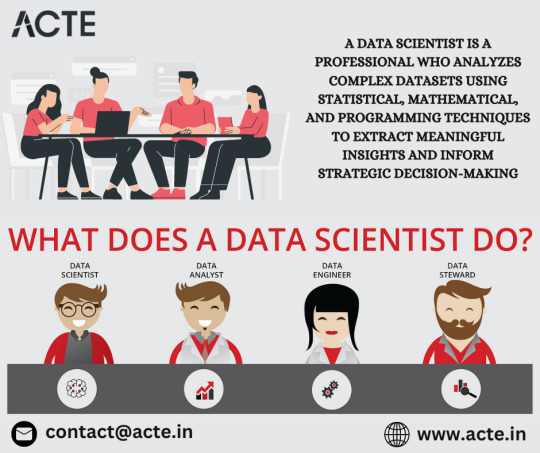
1. Data Exploration and Cleaning: Navigating the Data Seas
The odyssey begins with a deep dive into the vast data seas. Data scientists embark on a voyage of exploration, understanding the intricacies of datasets, identifying patterns, and cleansing the data to ensure its accuracy and relevance. This phase lays the foundation for the subsequent stages of analysis.
2. Statistical Analysis: Illuminating Patterns in the Darkness
Armed with statistical techniques, data scientists illuminate the darkness within the data. They apply statistical analysis to unveil trends, patterns, and relationships, transforming raw data into actionable insights. This statistical alchemy provides the groundwork for making informed decisions.
3. Machine Learning: Casting Predictive Spells
The heart of the data scientist's craft lies in machine learning—the art of teaching machines to learn from data. They develop and implement machine learning models, predicting outcomes, classifying data, or uncovering hidden patterns. It's a realm where algorithms become the guiding stars.
4. Data Visualization: Painting a Picture for All
To communicate the magic discovered within the data, data scientists harness the power of data visualization. Through charts, graphs, and dashboards, they paint a vivid picture, making complex insights accessible and compelling for both technical and non-technical stakeholders.
5. Feature Engineering: Crafting the Building Blocks
Much like a skilled architect, a data scientist engages in feature engineering. They carefully select and transform relevant features within the data, enhancing the performance and predictive power of machine learning models.
6. Predictive Modeling: Foretelling the Future
The crystal ball of a data scientist is the predictive model. Building upon historical data, they create models to forecast future trends, behaviors, or outcomes, guiding organizations towards proactive decision-making.
7. Algorithm Development: Coding the Spells
In the enchanting world of data science, programming becomes the language of spellcasting. Data scientists design and implement algorithms, utilizing languages such as Python or R to extract valuable information from the data tapestry.
8. Collaboration: Bridging Realms
No sorcerer works in isolation. Data scientists collaborate with cross-functional teams, translating data-driven insights into tangible business objectives. This collaboration ensures that the magic woven from data aligns seamlessly with the broader goals of the organization.
9. Continuous Learning: Evolving with the Arcane
In a landscape where technological evolutions are constant, data scientists embrace continuous learning. They stay abreast of the latest developments in data science, machine learning, and relevant technologies to refine their craft and adapt to the ever-changing tides of industry trends.
10. Ethical Considerations: Guardians of Data Integrity
As stewards of data, data scientists bear the responsibility of ethical considerations. They navigate the ethical landscape, ensuring the privacy and security of data while wielding their analytical powers for the greater good.
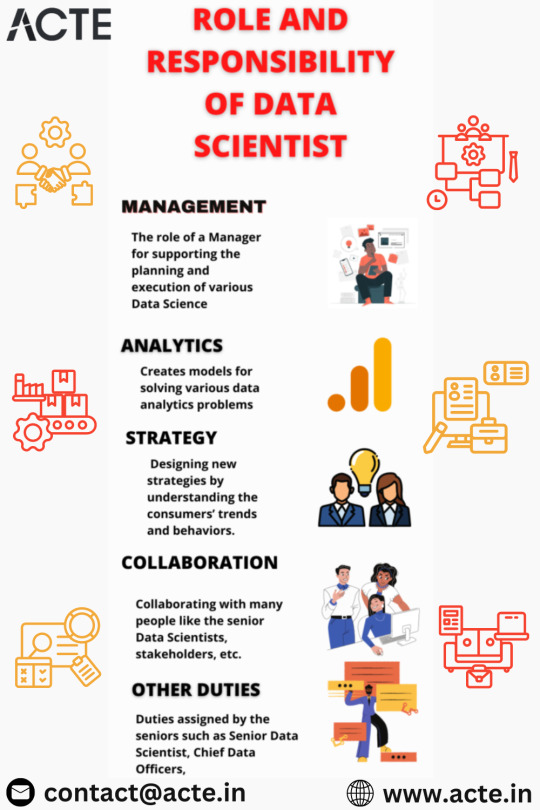
In conclusion, a data scientist's journey is one of constant exploration, analysis, and collaboration—a symphony of skills and knowledge harmonized to reveal the hidden melodies within data. In a world where data has become a strategic asset, data scientists are the custodians of its magic, turning raw information into insights that shape the destiny of organizations. Choosing the best Data Science Courses in Chennai is a crucial step in acquiring the necessary expertise for a successful career in the evolving landscape of data science.
4 notes
·
View notes